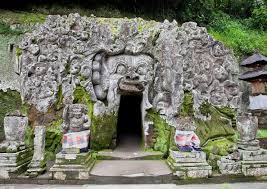
Goa Gajah is located in Bedulu village, Blahbatuh district, Gianyar district. This place can be reached approximately 45 minutes from the city of Denpasar. Goa Gajah is a historic tourist spot in the form of a cave with its artifacts. This place is interesting because it is surrounded by rice fields and small rivers. Goa Gajah is basically a cave where there are historical relics of Bali in the past. But not only historical artifacts exist but also the natural atmosphere that is so beautiful and charming. This tourist attraction is also surrounded by rice fields and rivers with always flowing water. There are four complexes in Goa Gajah namely cave complex with reliefs of Ganesha, Trilingga, Petirtaan (bathing place), and Tukad Pangkung valley where there are three branched relief stupas, 13-tiered umbrella reliefs, and Buddha statues.
History of Goa Gajah Temple
The origins of Goa Gajah cannot be known for sure. According to the Old Javanese book, Negarakertagama written by Mpu Prapanca in 1365 AD, the name Goa Gajah comes from the word “Lwa Gajah”, Lwa comes from lwah or loh which means water or river and Elephant is the name of the river which is now called the Petanu river. Another opinion says the name Goa Gajah comes from the statue of Ganesha which is in a cave in the northwest corner where the statue of Ganesha has a trunk like an elephant. In the Dawan inscription in 975 Saka and the Pandak Bandung inscription mentioned the name of the hermitage “Antakunjarapada”. When viewed from the meaning of the word ‘kunjara’ which means elephant, and ‘anta’ which means end or limit, while ‘at’ means place or region. Thus Antakunjarapada means a place of retreat located on the border of the Air Gajah region, which is now called Goa Gajah. Goa Gajah Hermitage, which in Sanskrit called Antakunjarapada can be linked to Kunjarakunja hermitage in southern India on the slopes of Mount Kunjara, the residence of Rsi Agastya, now called Agastya-malai. The environment around the Kunjarakunja hermitage which is in the mountains on the banks of the Tamraparni river which is thought to be the concept of naming the hermitage of Goa Gajah.
On the outside of this cave there is a pool with a shower which is a place to take holy water for ceremonial purposes. The pool, which was originally buried, was only discovered in 1954 by Krijgsman of the Archaeological Service at that time. And the statues found in the shower are statues of nymphs that may have 7 in number but only 5. The statues are divided into 2 groups, each of which has 3 showers lined up and one in the middle does not exist. Seven showers as a place for taking holy water take the concept of ‘Sapta Tirta’ which is 7 holy water which has the same value of chastity as ‘Sapta Nadi’ which is 7 consecrated rivers in India including the Ganges River, Sindhu River, Saraswati River, Yamuna River, Godawari River , the Serayu river, and the Darmada river. At this time, the ancient heritage of Goa Gajah has become a temple, namely Goa Gajah Temple, which is protected by the local community.